fuel JEEP GRAND CHEROKEE 2014 WK2 / 4.G Owner's Manual
[x] Cancel search | Manufacturer: JEEP, Model Year: 2014, Model line: GRAND CHEROKEE, Model: JEEP GRAND CHEROKEE 2014 WK2 / 4.GPages: 220, PDF Size: 6.12 MB
Page 172 of 220
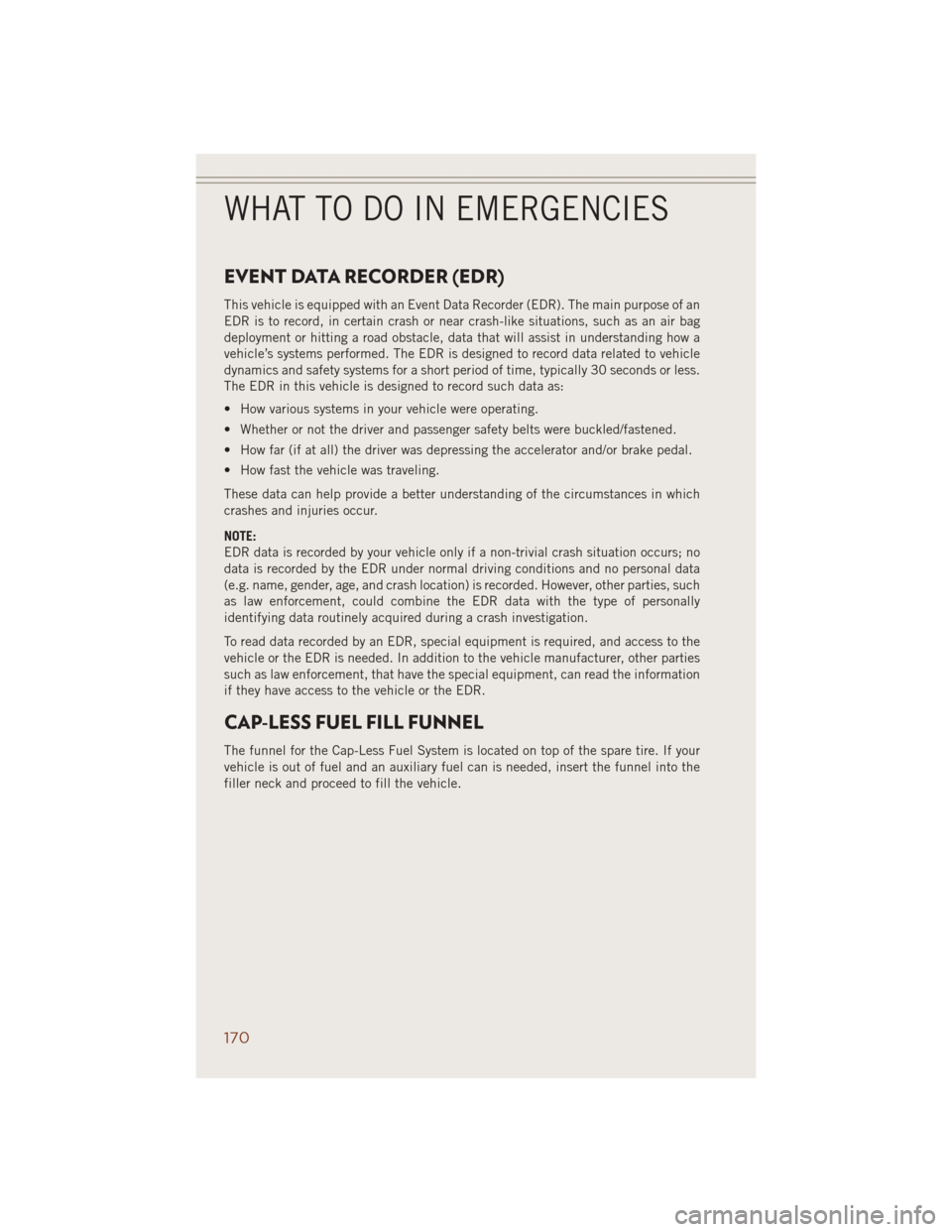
EVENT DATA RECORDER (EDR)
This vehicle is equipped with an Event Data Recorder (EDR). The main purpose of an
EDR is to record, in certain crash or near crash-like situations, such as an air bag
deployment or hitting a road obstacle, data that will assist in understanding how a
vehicle’s systems performed. The EDR is designed to record data related to vehicle
dynamics and safety systems for a short period of time, typically 30 seconds or less.
The EDR in this vehicle is designed to record such data as:
• How various systems in your vehicle were operating.
• Whether or not the driver and passenger safety belts were buckled/fastened.
• How far (if at all) the driver was depressing the accelerator and/or brake pedal.
• How fast the vehicle was traveling.
These data can help provide a better understanding of the circumstances in which
crashes and injuries occur.
NOTE:
EDR data is recorded by your vehicle only if a non-trivial crash situation occurs; no
data is recorded by the EDR under normal driving conditions and no personal data
(e.g. name, gender, age, and crash location) is recorded. However, other parties, such
as law enforcement, could combine the EDR data with the type of personally
identifying data routinely acquired during a crash investigation.
To read data recorded by an EDR, special equipment is required, and access to the
vehicle or the EDR is needed. In addition to the vehicle manufacturer, other parties
such as law enforcement, that have the special equipment, can read the information
if they have access to the vehicle or the EDR.
CAP-LESS FUEL FILL FUNNEL
The funnel for the Cap-Less Fuel System is located on top of the spare tire. If your
vehicle is out of fuel and an auxiliary fuel can is needed, insert the funnel into the
filler neck and proceed to fill the vehicle.
WHAT TO DO IN EMERGENCIES
170
Page 174 of 220
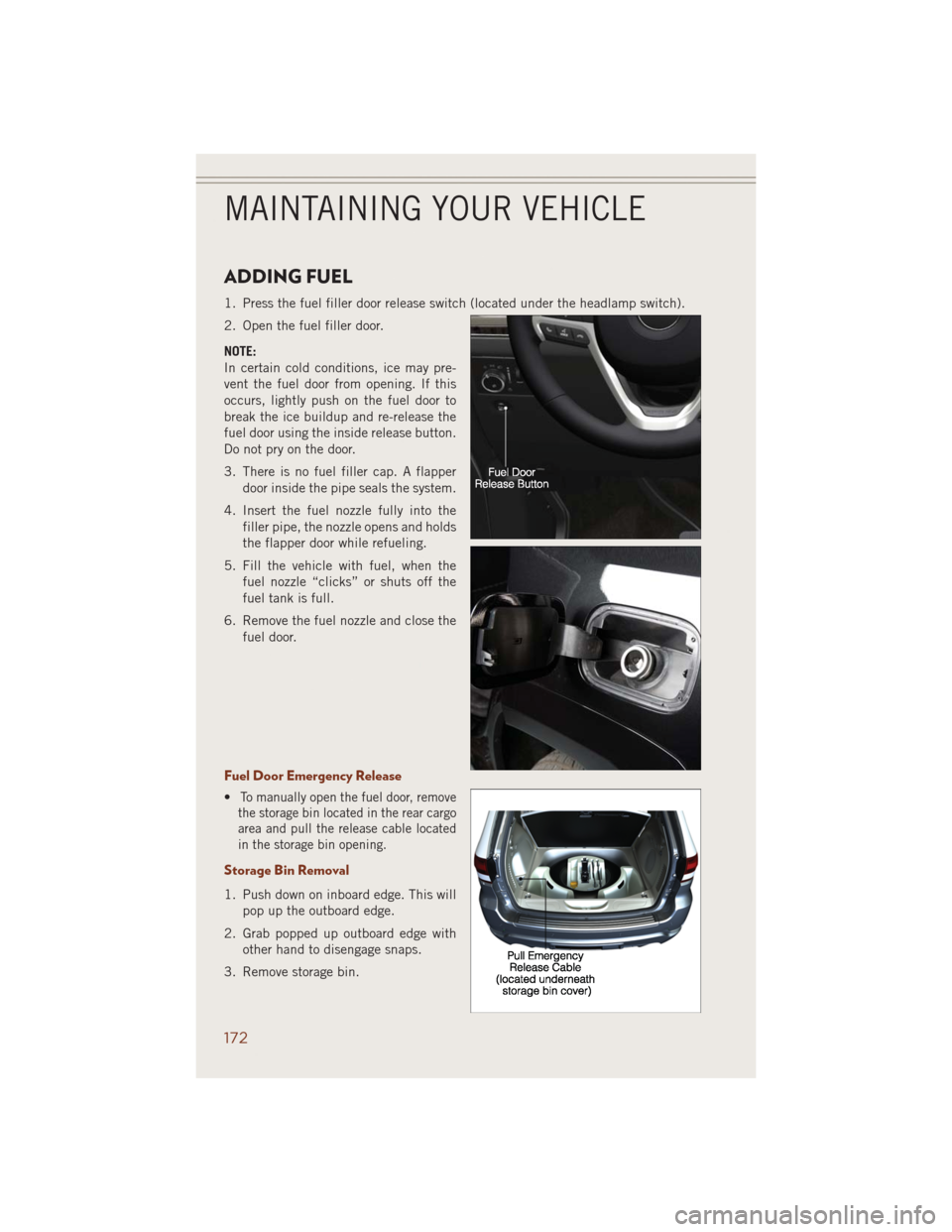
ADDING FUEL
1. Press the fuel filler door release switch (located under the headlamp switch).
2. Open the fuel filler door.
NOTE:
In certain cold conditions, ice may pre-
vent the fuel door from opening. If this
occurs, lightly push on the fuel door to
break the ice buildup and re-release the
fuel door using the inside release button.
Do not pry on the door.
3. There is no fuel filler cap. A flapper
door inside the pipe seals the system.
4. Insert the fuel nozzle fully into the
filler pipe, the nozzle opens and holds
the flapper door while refueling.
5. Fill the vehicle with fuel, when the
fuel nozzle “clicks” or shuts off the
fuel tank is full.
6. Remove the fuel nozzle and close the
fuel door.
Fuel Door Emergency Release
•To manually open the fuel door, remove
the storage bin located in the rear cargo
area and pull the release cable located
in the storage bin opening.
Storage Bin Removal
1. Push down on inboard edge. This will
pop up the outboard edge.
2. Grab popped up outboard edge with
other hand to disengage snaps.
3. Remove storage bin.
MAINTAINING YOUR VEHICLE
172
Page 180 of 220
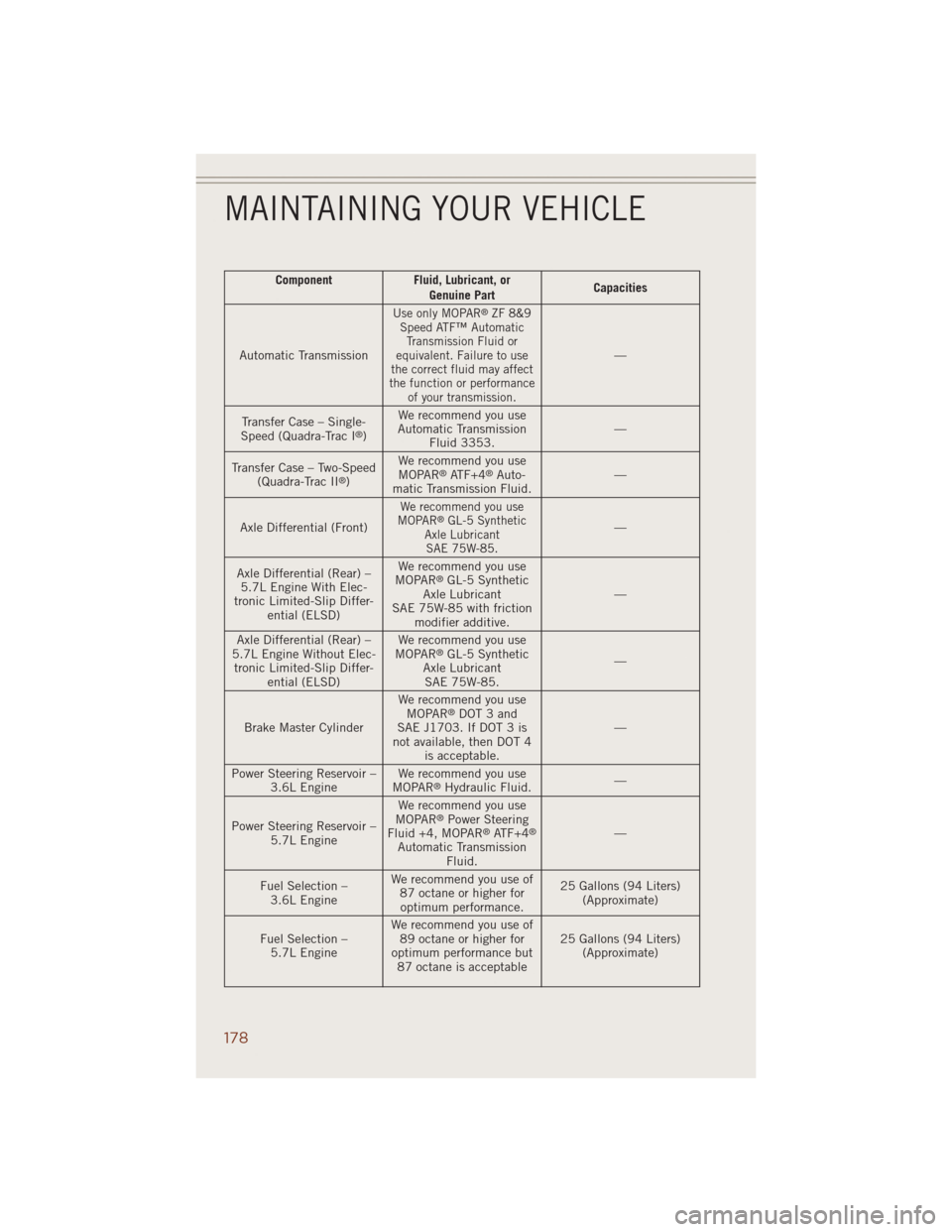
Component Fluid, Lubricant, or
Genuine PartCapacities
Automatic Transmission
Use only MOPAR®ZF 8&9
Speed ATF™ Automatic
Transmission Fluid or
equivalent. Failure to use
the correct fluid may affect
the function or performance
of your transmission.
—
Transfer Case – Single-
Speed (Quadra-Trac I
®)We recommend you use
Automatic Transmission
Fluid 3353.—
Transfer Case – Two-Speed
(Quadra-Trac II
®)We recommend you use
MOPAR®ATF+4®Auto-
matic Transmission Fluid.—
Axle Differential (Front)
We recommend you use
MOPAR®GL-5 Synthetic
Axle Lubricant
SAE 75W-85.—
Axle Differential (Rear) –
5.7L Engine With Elec-
tronic Limited-Slip Differ-
ential (ELSD)We recommend you use
MOPAR
®GL-5 Synthetic
Axle Lubricant
SAE 75W-85 with friction
modifier additive.—
Axle Differential (Rear) –
5.7L Engine Without Elec-
tronic Limited-Slip Differ-
ential (ELSD)We recommend you use
MOPAR
®GL-5 Synthetic
Axle Lubricant
SAE 75W-85.—
Brake Master CylinderWe recommend you use
MOPAR
®DOT 3 and
SAE J1703. If DOT 3 is
not available, then DOT 4
is acceptable.—
Power Steering Reservoir –
3.6L EngineWe recommend you use
MOPAR
®Hydraulic Fluid.—
Power Steering Reservoir –
5.7L EngineWe recommend you use
MOPAR
®Power Steering
Fluid +4, MOPAR®ATF+4®
Automatic Transmission
Fluid.—
Fuel Selection –
3.6L EngineWe recommend you use of
87 octane or higher for
optimum performance.25 Gallons (94 Liters)
(Approximate)
Fuel Selection –
5.7L EngineWe recommend you use of
89 octane or higher for
optimum performance but
87 octane is acceptable25 Gallons (94 Liters)
(Approximate)
MAINTAINING YOUR VEHICLE
178
Page 182 of 220
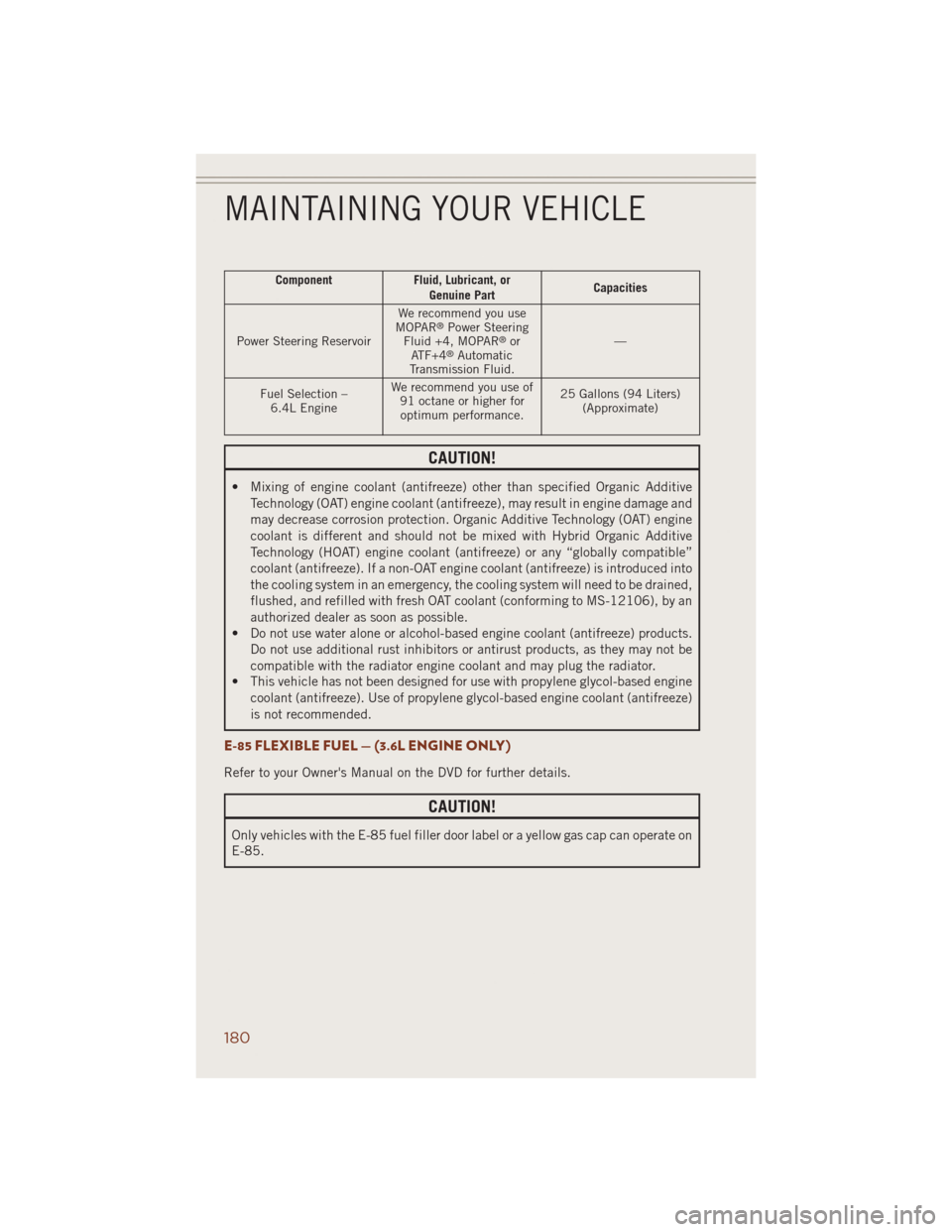
Component Fluid, Lubricant, or
Genuine PartCapacities
Power Steering ReservoirWe recommend you use
MOPAR
®Power Steering
Fluid +4, MOPAR®or
ATF+4®Automatic
Transmission Fluid.—
Fuel Selection –
6.4L EngineWe recommend you use of
91 octane or higher for
optimum performance.25 Gallons (94 Liters)
(Approximate)
CAUTION!
• Mixing of engine coolant (antifreeze) other than specified Organic Additive
Technology (OAT) engine coolant (antifreeze), may result in engine damage and
may decrease corrosion protection. Organic Additive Technology (OAT) engine
coolant is different and should not be mixed with Hybrid Organic Additive
Technology (HOAT) engine coolant (antifreeze) or any “globally compatible”
coolant (antifreeze). If a non-OAT engine coolant (antifreeze) is introduced into
the cooling system in an emergency, the cooling system will need to be drained,
flushed, and refilled with fresh OAT coolant (conforming to MS-12106), by an
authorized dealer as soon as possible.
• Do not use water alone or alcohol-based engine coolant (antifreeze) products.
Do not use additional rust inhibitors or antirust products, as they may not be
compatible with the radiator engine coolant and may plug the radiator.
• This vehicle has not been designed for use with propylene glycol-based engine
coolant (antifreeze). Use of propylene glycol-based engine coolant (antifreeze)
is not recommended.
E-85 FLEXIBLE FUEL — (3.6L ENGINE ONLY)
Refer to your Owner's Manual on the DVD for further details.
CAUTION!
Only vehicles with the E-85 fuel filler door label or a yellow gas cap can operate on
E-85.
MAINTAINING YOUR VEHICLE
180
Page 183 of 220
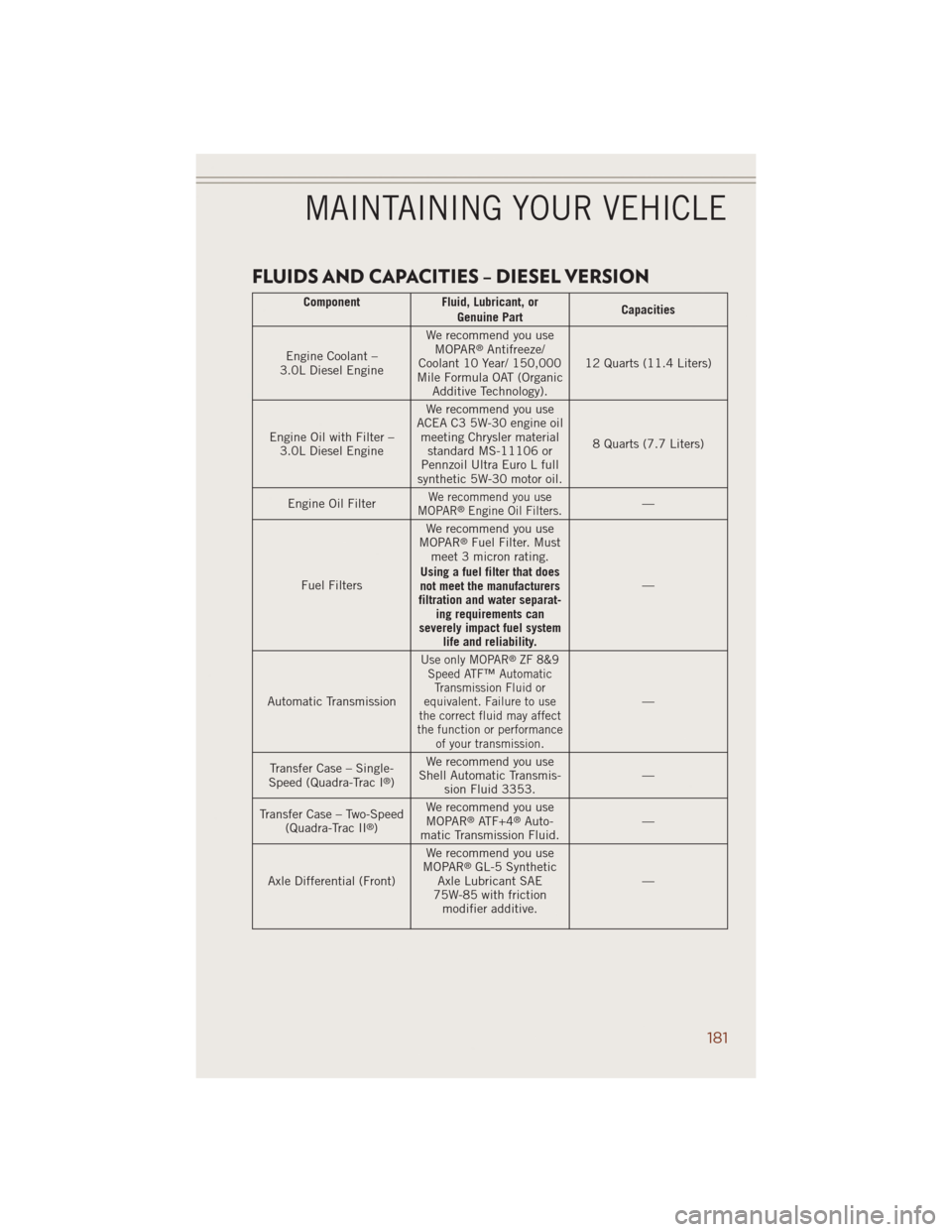
FLUIDS AND CAPACITIES – DIESEL VERSION
Component Fluid, Lubricant, or
Genuine PartCapacities
Engine Coolant –
3.0L Diesel EngineWe recommend you use
MOPAR
®Antifreeze/
Coolant 10 Year/ 150,000
Mile Formula OAT (Organic
Additive Technology).12 Quarts (11.4 Liters)
Engine Oil with Filter –
3.0L Diesel EngineWe recommend you use
ACEA C3 5W-30 engine oil
meeting Chrysler material
standard MS-11106 or
Pennzoil Ultra Euro L full
synthetic 5W-30 motor oil.8 Quarts (7.7 Liters)
Engine Oil Filter
We recommend you use
MOPAR®Engine Oil Filters.—
Fuel FiltersWe recommend you use
MOPAR
®Fuel Filter. Must
meet 3 micron rating.
Using a fuel filter that does
not meet the manufacturers
filtration and water separat-
ing requirements can
severely impact fuel system
life and reliability.—
Automatic Transmission
Use only MOPAR®ZF 8&9
Speed ATF™ Automatic
Transmission Fluid or
equivalent. Failure to use
the correct fluid may affect
the function or performance
of your transmission.
—
Transfer Case – Single-
Speed (Quadra-Trac I
®)We recommend you use
Shell Automatic Transmis-
sion Fluid 3353.—
Transfer Case – Two-Speed
(Quadra-Trac II
®)We recommend you use
MOPAR®ATF+4®Auto-
matic Transmission Fluid.—
Axle Differential (Front)We recommend you use
MOPAR
®GL-5 Synthetic
Axle Lubricant SAE
75W-85 with friction
modifier additive.—
MAINTAINING YOUR VEHICLE
181
Page 185 of 220
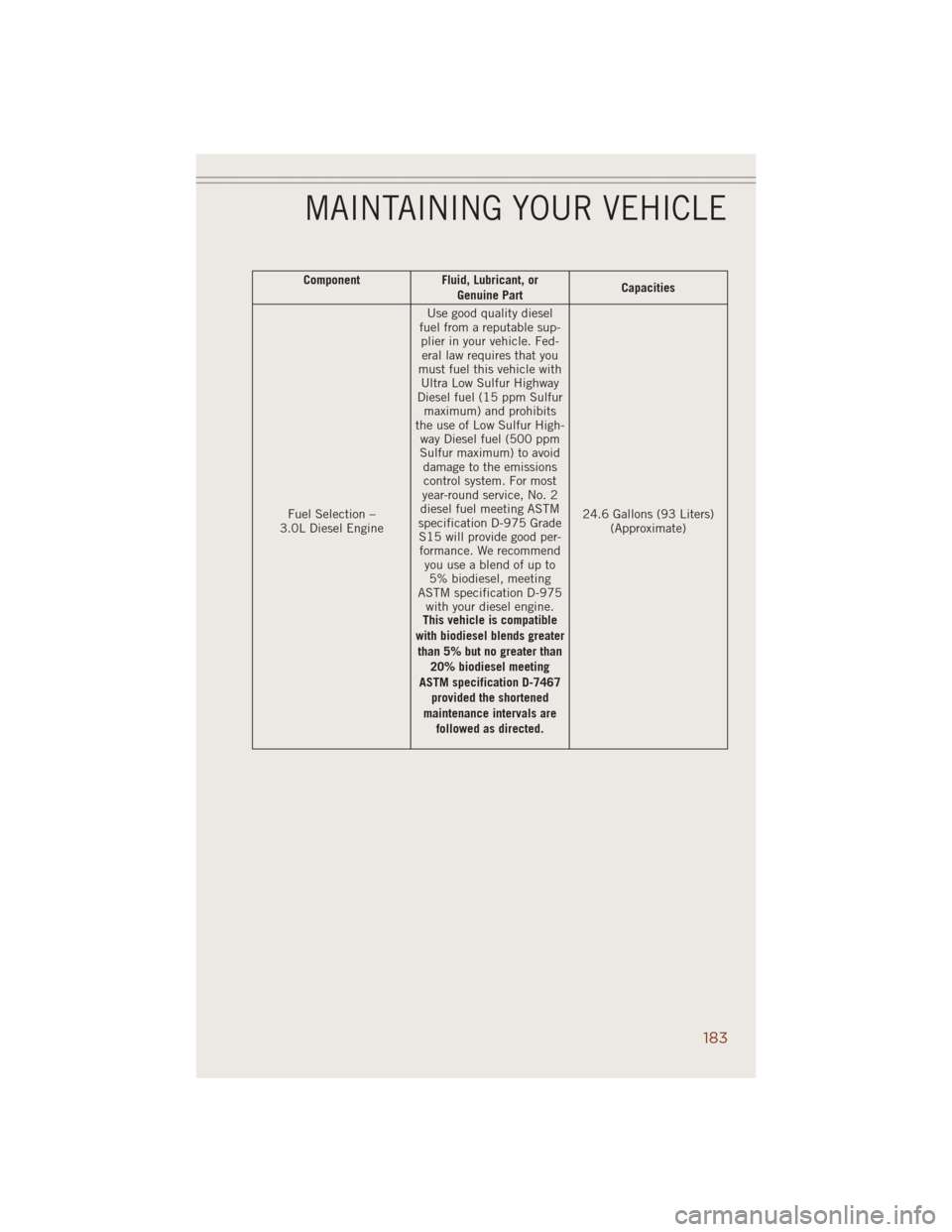
Component Fluid, Lubricant, or
Genuine PartCapacities
Fuel Selection –
3.0L Diesel EngineUse good quality diesel
fuel from a reputable sup-
plier in your vehicle. Fed-
eral law requires that you
must fuel this vehicle with
Ultra Low Sulfur Highway
Diesel fuel (15 ppm Sulfur
maximum) and prohibits
the use of Low Sulfur High-
way Diesel fuel (500 ppm
Sulfur maximum) to avoid
damage to the emissions
control system. For most
year-round service, No. 2
diesel fuel meeting ASTM
specification D-975 Grade
S15 will provide good per-
formance. We recommend
youuseablendofupto
5% biodiesel, meeting
ASTM specification D-975
with your diesel engine.
This vehicle is compatible
with biodiesel blends greater
than 5% but no greater than
20% biodiesel meeting
ASTM specification D-7467
provided the shortened
maintenance intervals are
followed as directed.24.6 Gallons (93 Liters)
(Approximate)
MAINTAINING YOUR VEHICLE
183
Page 186 of 220
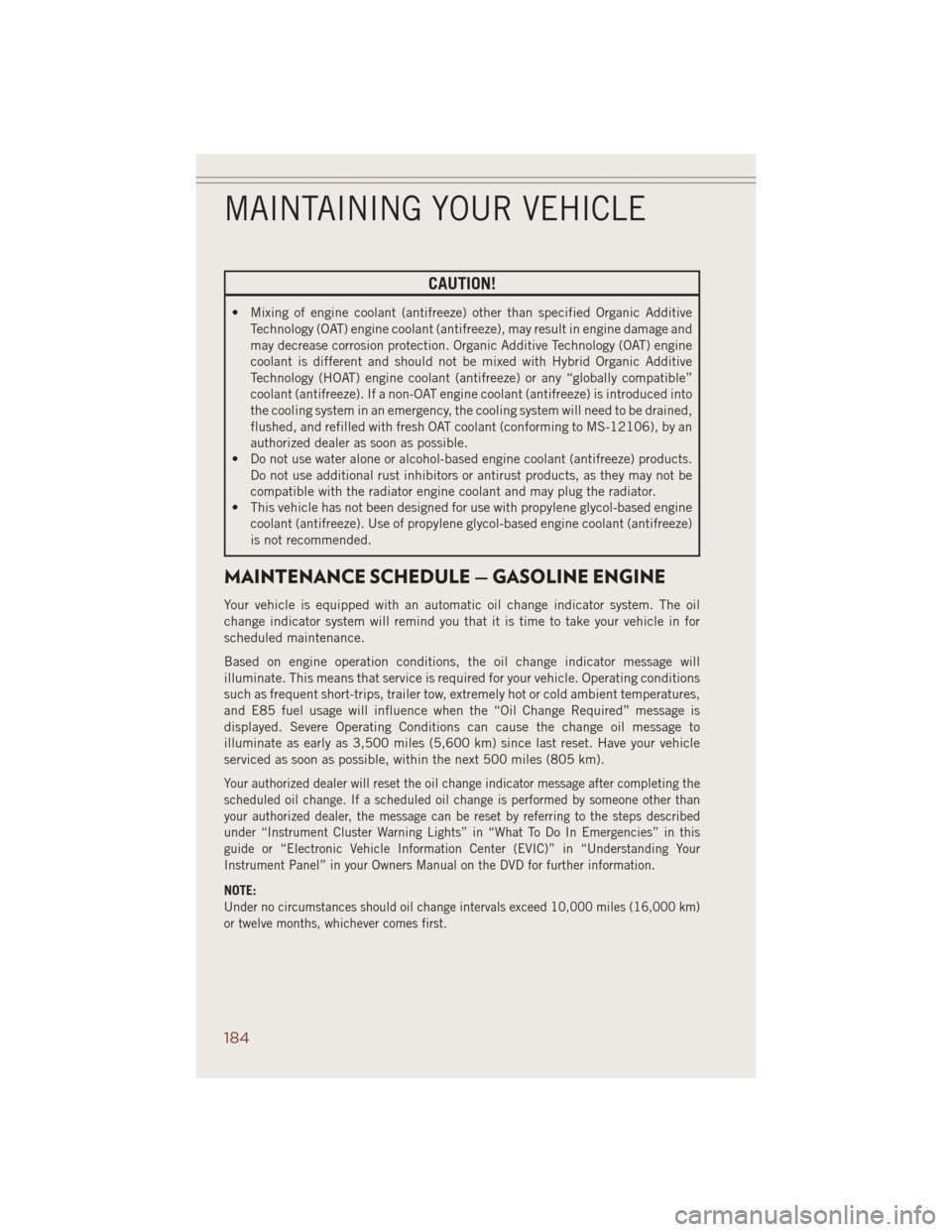
CAUTION!
• Mixing of engine coolant (antifreeze) other than specified Organic Additive
Technology (OAT) engine coolant (antifreeze), may result in engine damage and
may decrease corrosion protection. Organic Additive Technology (OAT) engine
coolant is different and should not be mixed with Hybrid Organic Additive
Technology (HOAT) engine coolant (antifreeze) or any “globally compatible”
coolant (antifreeze). If a non-OAT engine coolant (antifreeze) is introduced into
the cooling system in an emergency, the cooling system will need to be drained,
flushed, and refilled with fresh OAT coolant (conforming to MS-12106), by an
authorized dealer as soon as possible.
• Do not use water alone or alcohol-based engine coolant (antifreeze) products.
Do not use additional rust inhibitors or antirust products, as they may not be
compatible with the radiator engine coolant and may plug the radiator.
• This vehicle has not been designed for use with propylene glycol-based engine
coolant (antifreeze). Use of propylene glycol-based engine coolant (antifreeze)
is not recommended.
MAINTENANCE SCHEDULE — GASOLINE ENGINE
Your vehicle is equipped with an automatic oil change indicator system. The oil
change indicator system will remind you that it is time to take your vehicle in for
scheduled maintenance.
Based on engine operation conditions, the oil change indicator message will
illuminate. This means that service is required for your vehicle. Operating conditions
such as frequent short-trips, trailer tow, extremely hot or cold ambient temperatures,
and E85 fuel usage will influence when the “Oil Change Required” message is
displayed. Severe Operating Conditions can cause the change oil message to
illuminate as early as 3,500 miles (5,600 km) since last reset. Have your vehicle
serviced as soon as possible, within the next 500 miles (805 km).
Your authorized dealer will reset the oil change indicator message after completing the
scheduled oil change. If a scheduled oil change is performed by someone other than
your authorized dealer, the message can be reset by referring to the steps described
under “Instrument Cluster Warning Lights” in “What To Do In Emergencies” in this
guide or “Electronic Vehicle Information Center (EVIC)” in “Understanding Your
Instrument Panel” in your Owners Manual on the DVD for further information.
NOTE:
Under no circumstances should oil change intervals exceed 10,000 miles (16,000 km)
or twelve months, whichever comes first.
MAINTAINING YOUR VEHICLE
184
Page 192 of 220
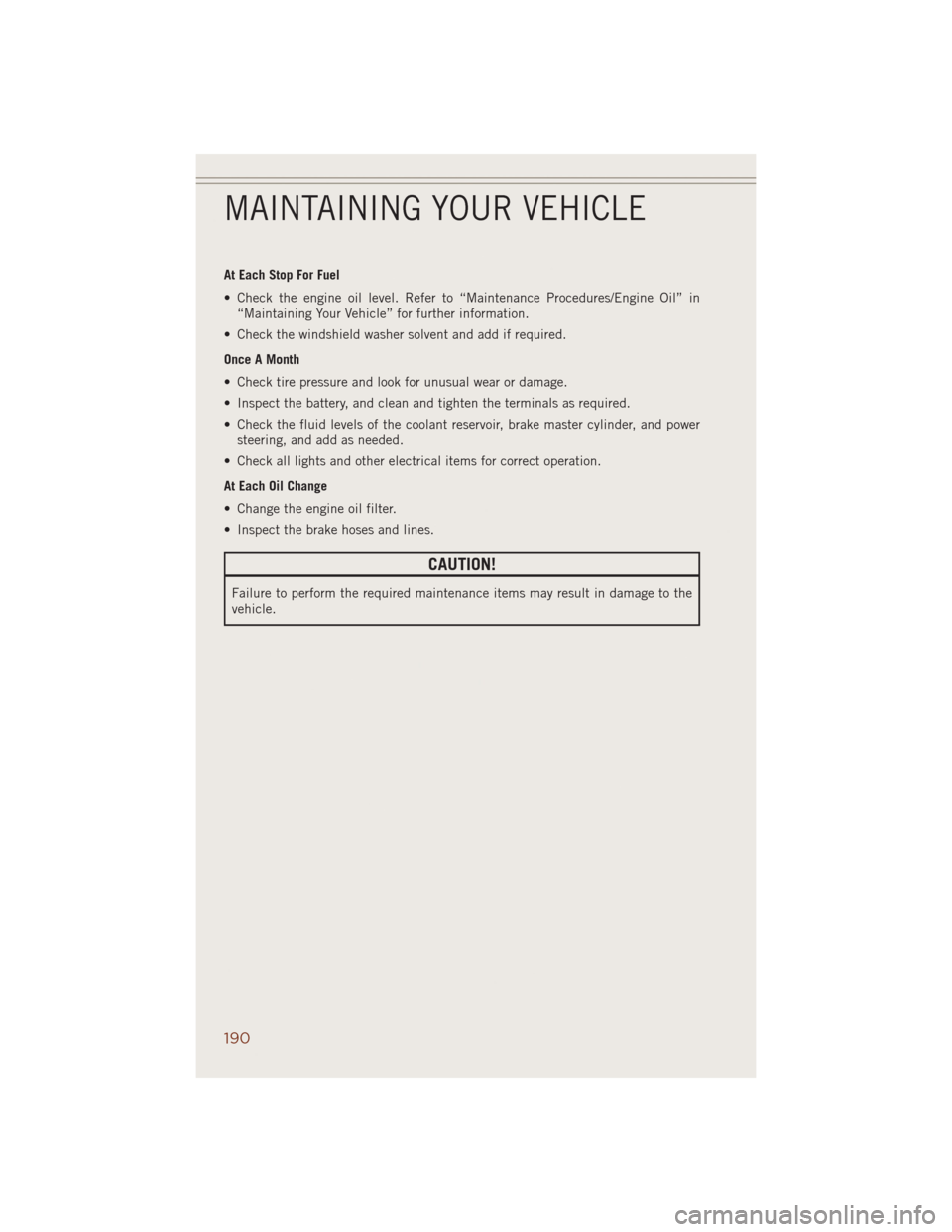
At Each Stop For Fuel
• Check the engine oil level. Refer to “Maintenance Procedures/Engine Oil” in
“Maintaining Your Vehicle” for further information.
• Check the windshield washer solvent and add if required.
Once A Month
• Check tire pressure and look for unusual wear or damage.
• Inspect the battery, and clean and tighten the terminals as required.
• Check the fluid levels of the coolant reservoir, brake master cylinder, and power
steering, and add as needed.
• Check all lights and other electrical items for correct operation.
At Each Oil Change
• Change the engine oil filter.
• Inspect the brake hoses and lines.
CAUTION!
Failure to perform the required maintenance items may result in damage to the
vehicle.
MAINTAINING YOUR VEHICLE
190
Page 198 of 220
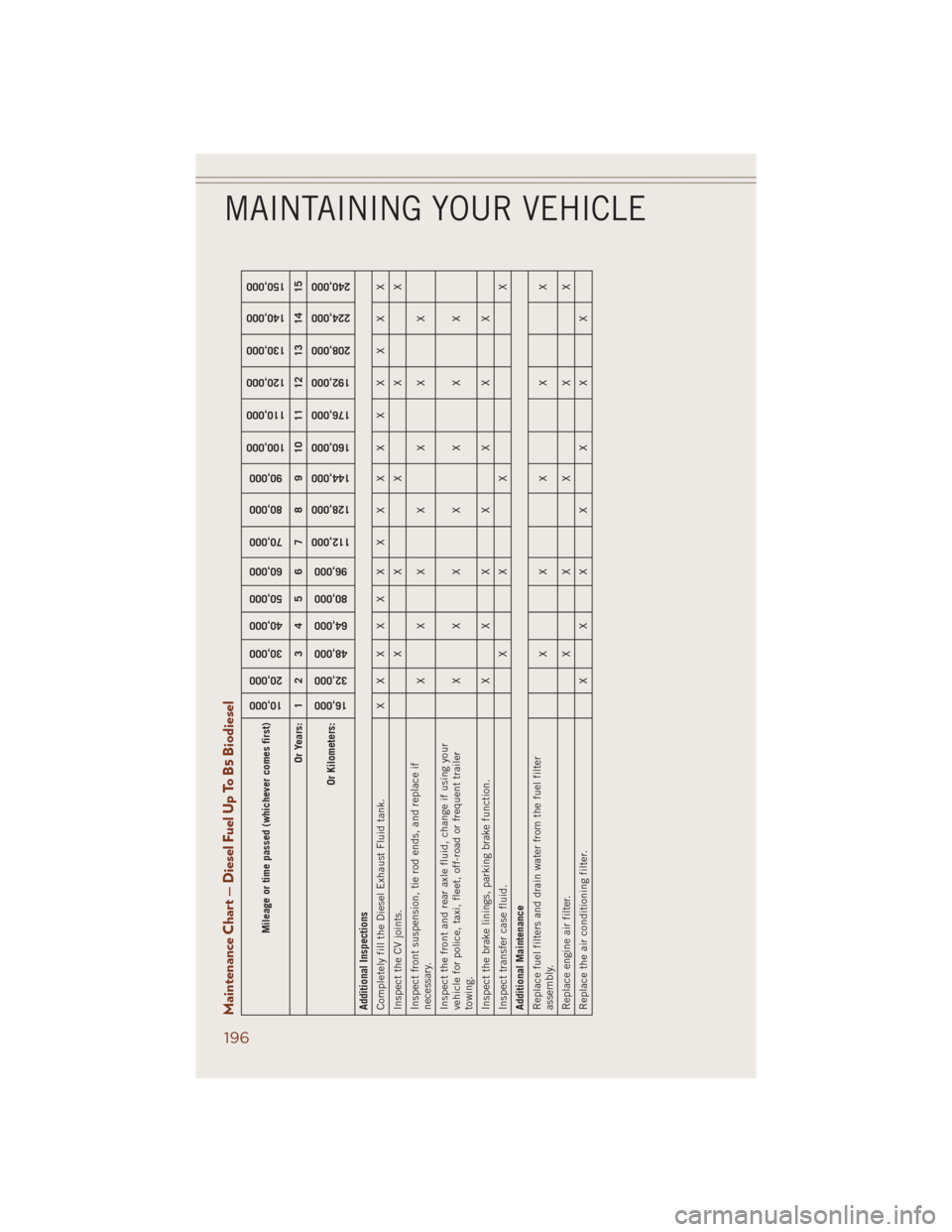
Maintenance Chart — Diesel Fuel Up To B5 Biodiesel
Mileage or time passed (whichever comes first)
10,000
20,000
30,000
40,000
50,000
60,000
70,000
80,000
90,000
100,000
110,000
120,000
130,000
140,000
150,000
Or Years: 1 2 3 4 5 6 7 8 9 10 11 12 13 14 15
Or Kilometers:
16,000
32,000
48,000
64,000
80,000
96,000
112,000
128,000
144,000
160,000
176,000
192,000
208,000
224,000
240,000
Additional Inspections
Completely fill the Diesel Exhaust Fluid tank. X X X X X X X X X X X X X X X
Inspect the CV joints. X X X X X
Inspect front suspension, tie rod ends, and replace if
necessary.XXX X X X X
Inspect the front and rear axle fluid, change if using your
vehicle for police, taxi, fleet, off-road or frequent trailer
towing.XXX X X X X
Inspect the brake linings, parking brake function. X X X X X X X
Inspect transfer case fluid. X X X X
Additional Maintenance
Replace fuel filters and drain water from the fuel filter
assembly.XX X X X
Replace engine air filter. X X X X X
Replace the air conditioning filter. X X X X X X X
MAINTAINING YOUR VEHICLE
196
Page 200 of 220
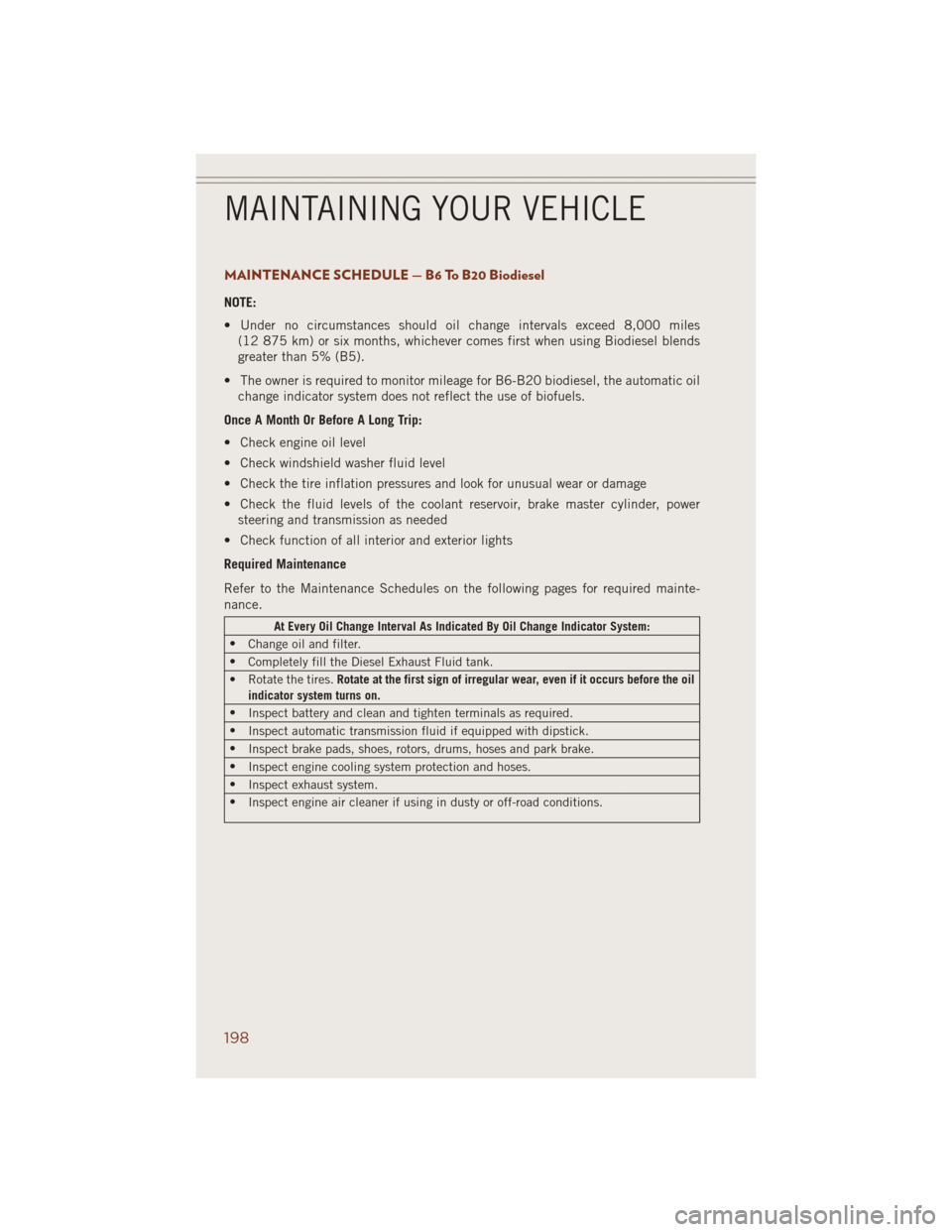
MAINTENANCE SCHEDULE — B6 To B20 Biodiesel
NOTE:
• Under no circumstances should oil change intervals exceed 8,000 miles
(12 875 km) or six months, whichever comes first when using Biodiesel blends
greater than 5% (B5).
• The owner is required to monitor mileage for B6-B20 biodiesel, the automatic oil
change indicator system does not reflect the use of biofuels.
Once A Month Or Before A Long Trip:
• Check engine oil level
• Check windshield washer fluid level
• Check the tire inflation pressures and look for unusual wear or damage
• Check the fluid levels of the coolant reservoir, brake master cylinder, power
steering and transmission as needed
• Check function of all interior and exterior lights
Required Maintenance
Refer to the Maintenance Schedules on the following pages for required mainte-
nance.
At Every Oil Change Interval As Indicated By Oil Change Indicator System:
•
Change oil and filter.
•
Completely fill the Diesel Exhaust Fluid tank.
• Rotate the tires.Rotate at the first sign of irregular wear, even if it occurs before the oil
indicator system turns on.
•
Inspect battery and clean and tighten terminals as required.
•
Inspect automatic transmission fluid if equipped with dipstick.
•
Inspect brake pads, shoes, rotors, drums, hoses and park brake.
•
Inspect engine cooling system protection and hoses.
•
Inspect exhaust system.
•
Inspect engine air cleaner if using in dusty or off-road conditions.
MAINTAINING YOUR VEHICLE
198